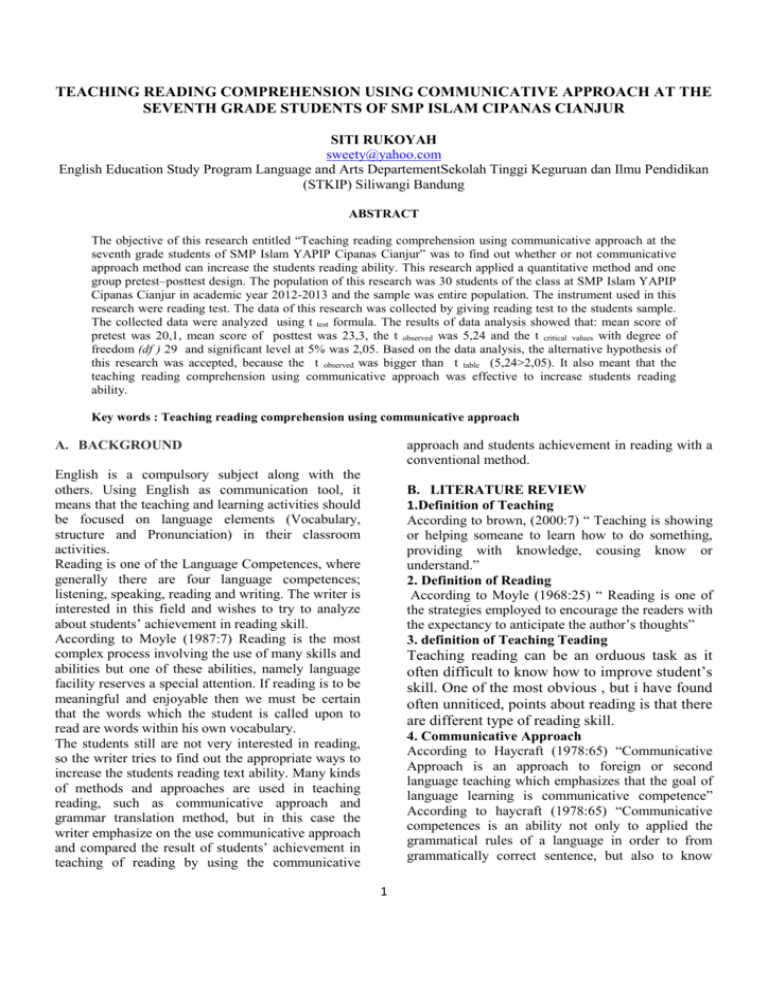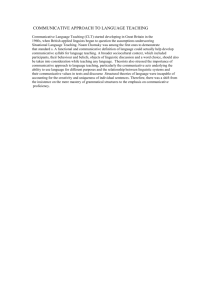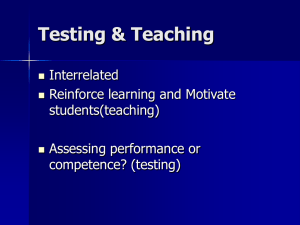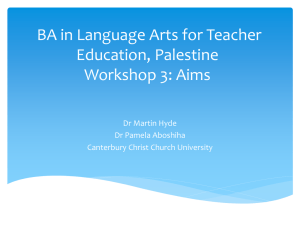TEACHING READING COMPREHENSION USING
advertisement

TEACHING READING COMPREHENSION USING COMMUNICATIVE APPROACH AT THE SEVENTH GRADE STUDENTS OF SMP ISLAM CIPANAS CIANJUR SITI RUKOYAH sweety@yahoo.com English Education Study Program Language and Arts DepartementSekolah Tinggi Keguruan dan Ilmu Pendidikan (STKIP) Siliwangi Bandung ABSTRACT The objective of this research entitled “Teaching reading comprehension using communicative approach at the seventh grade students of SMP Islam YAPIP Cipanas Cianjur” was to find out whether or not communicative approach method can increase the students reading ability. This research applied a quantitative method and one group pretest–posttest design. The population of this research was 30 students of the class at SMP Islam YAPIP Cipanas Cianjur in academic year 2012-2013 and the sample was entire population. The instrument used in this research were reading test. The data of this research was collected by giving reading test to the students sample. The collected data were analyzed using t test formula. The results of data analysis showed that: mean score of pretest was 20,1, mean score of posttest was 23,3, the t observed was 5,24 and the t critical values with degree of freedom (df ) 29 and significant level at 5% was 2,05. Based on the data analysis, the alternative hypothesis of this research was accepted, because the t observed was bigger than t table (5,24>2,05). It also meant that the teaching reading comprehension using communicative approach was effective to increase students reading ability. Key words : Teaching reading comprehension using communicative approach approach and students achievement in reading with a conventional method. A. BACKGROUND English is a compulsory subject along with the others. Using English as communication tool, it means that the teaching and learning activities should be focused on language elements (Vocabulary, structure and Pronunciation) in their classroom activities. Reading is one of the Language Competences, where generally there are four language competences; listening, speaking, reading and writing. The writer is interested in this field and wishes to try to analyze about students’ achievement in reading skill. According to Moyle (1987:7) Reading is the most complex process involving the use of many skills and abilities but one of these abilities, namely language facility reserves a special attention. If reading is to be meaningful and enjoyable then we must be certain that the words which the student is called upon to read are words within his own vocabulary. The students still are not very interested in reading, so the writer tries to find out the appropriate ways to increase the students reading text ability. Many kinds of methods and approaches are used in teaching reading, such as communicative approach and grammar translation method, but in this case the writer emphasize on the use communicative approach and compared the result of students’ achievement in teaching of reading by using the communicative B. LITERATURE REVIEW 1.Definition of Teaching According to brown, (2000:7) “ Teaching is showing or helping someane to learn how to do something, providing with knowledge, cousing know or understand.” 2. Definition of Reading According to Moyle (1968:25) “ Reading is one of the strategies employed to encourage the readers with the expectancy to anticipate the author’s thoughts” 3. definition of Teaching Teading Teaching reading can be an orduous task as it often difficult to know how to improve student’s skill. One of the most obvious , but i have found often unniticed, points about reading is that there are different type of reading skill. 4. Communicative Approach According to Haycraft (1978:65) “Communicative Approach is an approach to foreign or second language teaching which emphasizes that the goal of language learning is communicative competence” According to haycraft (1978:65) “Communicative competences is an ability not only to applied the grammatical rules of a language in order to from grammatically correct sentence, but also to know 1 when and where to use these whom.” sentence and to 1. Description of Data The table shows the results of the students scores at pretest and posttest C. RESEARCH METHODOLOGY 1. Research Design Research design which was used in this study one group pre test and post test In this design, the subject of the pre test and post test were the same. The writer computed the average score of pretest and posttest to see whether this technique gave significant result to increase of students reading comprehension, then the average score pre-test and post-test were compared. The sceme of one group pre-test and post test design can be seen as follows: O1→ 𝑥 →O2 (Hatch & Farhady, 1982:115) 2. Research Method This is a quantitative research, which relies data based on computation and measurement. “Quantitative research methods are used to examine questions that can be answered by collecting statistically analyzing data that are in numerical form.”(Crowl, 1996:10). The data measured are in the form of numbers. The method of the research is pre-experiment. Preexperiment is the simplest form of research design. In pre-experiment either a single groups are observed subsequent to some agent or treatment presumed to cause change. It was meant to find out the level of significance of the treatment communicative approach on students’ achievement in her research. The test was given to the students twice, before treatment and after treatment to measure the influence or benefit of the treatment in teaching reading. The population may be all the individuals of a particular type or more restricted part of that group. The population in this study was the students of seventh grade at SMP Islam YAPIP Cipanas Cianjur. In the academic year 2012/2013 which was of one classes and class consisted of 30 students. No Class 1 2 3 4 5 6 7 8 9 10 11 12 13 14 15 16 17 18 19 20 21 22 23 24 25 26 27 28 29 30 1 2 3 4 5 6 7 Total X 18 18 18 18 18 18 18 18 19 19 19 19 19 20 20 20 20 20 20 20 21 21 21 22 22 22 23 24 24 24 603 Y 21 21 21 21 21 21 22 22 22 22 22 22 22 23 23 23 24 24 24 24 24 24 24 25 25 25 26 27 27 27 699 D= (X-Y) -3 -3 -3 -3 -3 -3 -4 -4 -3 -3 -3 -3 -3 -3 -3 -3 -4 -4 -4 -4 -3 -3 -3 -3 -3 -3 -3 -3 -3 -3 -96 D2 = (X-Y)2 9 9 9 9 9 9 16 16 9 9 9 9 9 9 9 9 16 16 16 16 9 9 9 9 9 9 9 9 9 9 312 Student Student Student Student Student Student Student Student Student Student Student Student Student Student Student Student Student Student Student Student Student Student Student Student Student Student Student Student Student Student Student 10 14 15 24 26 9 11 8 20 23 25 27 5 1 17 30 12 29 6 7 13 28 4 19 21 3 2 16 18 22 From the table above, we can see that the summation of pre-test is 603 and the mean of pre-test is 20,1. Meanwhile, the summation of post-test is 699 and the mean of post-test is 23,3. The difference between the scores of one person is -96 and the squared difference between the scores of one person is 312. To find out the mean of differences (MD) between variable X and Y, the writer used the formula: D N 96 MD 30 MD -3,2 MD D. FINDINGS AND DISCUSSIONS In this research, after the writer have done observasition and research at SMP Islam YAPIP the result score obtained from the pretest and posttest, the writer took seventh grade for teaching reading comprehension The last calculation is determining the result of t observation (to) of the test with formula: 2 to Introducti,on to Research Method. Australia: Longman Ltd MD SE MD 3,2 0,61 to 5,24 To determine if the t value is statistically significant, it is first necessary to determine how many df there are. The writer calculated the df as follow to Crowl, Thomas K. (1996). Fundamentals of Educational Research, Second edition. The college of staten island: City university of New York. df N 1 Haycraft, John. (1978). An Introduction to English Language Teaching. USA: Longman Ltd. df 30 1 df 29 Moyle, D. (1968) The Teaching of Reading. USA: Word lock Education E. BIBLIOGRAPHY Brown, H. Douglash. (1987). Principles of Language Learning and Teaching.New jersey: Prentice Hall. Burn. Robert B. (1991). 3






